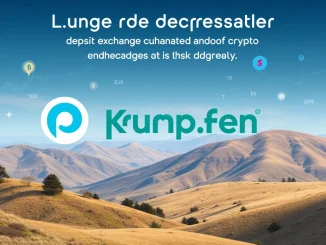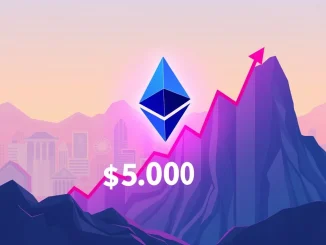
Well, this is certainly tough news for the Web3 gaming world. Remember Ember Sword? The highly anticipated Ethereum-based MMORPG that made waves by raising a massive $203 million through NFT land sales? After years in development and generating significant hype, developer Bright Star Studios has announced that Ember Sword is shutting down, citing a lack of funding.
What Happened with Ember Sword?
For many, the news of Ember Sword’s demise comes as a shock, especially given the staggering amount of capital it initially secured. Here’s a quick breakdown:
- The Game: Ember Sword was envisioned as a free-to-play, player-driven sandbox MMORPG built on the Ethereum blockchain.
- The Hype: It gained considerable attention early on, promising true player ownership of assets (NFTs) and a deep, engaging world.
- The Funding: A significant portion of its funding, reportedly $203 million, came from selling virtual land parcels as NFTs. This was one of the largest NFT raises seen in the gaming space at the time.
- The Shutdown: Despite this substantial war chest, the studio stated that insufficient funding ultimately led to the decision to cease operations.
This situation raises serious questions about the sustainability of funding models heavily reliant on early-stage NFT sales, especially when development cycles are long and market conditions shift.
Is This a Sign of a Wider Crypto Gaming Problem?
Ember Sword isn’t the first crypto game to face significant challenges or even shut down, and it likely won’t be the last. Its closure adds to a growing list of projects struggling in the current climate. But does this mean the entire crypto gaming sector is collapsing?
The truth is complex. The market downturn across cryptocurrencies and NFTs has undoubtedly impacted funding, investor confidence, and even player interest in games tied to these volatile assets. Many projects launched during the peak of the hype cycle are now finding it difficult to secure follow-on funding or maintain player bases that were perhaps more interested in speculative gains than gameplay.
Challenges facing the sector include:
- Difficulty balancing sustainable in-game economies with speculative elements.
- High development costs for quality games compared to the revenue generated.
- Regulatory uncertainty in various jurisdictions.
- Negative sentiment surrounding NFTs and ‘play-to-earn’ models that felt more like work than fun.
- Technical hurdles related to integrating blockchain seamlessly into gameplay.
The State of NFT Games Beyond the Hype
The initial wave of NFT games often prioritized the tokenomics and asset trading over core gameplay loops. While Ember Sword aimed to be a full-fledged MMORPG, its funding model was heavily rooted in NFT speculation. This highlights a critical challenge:
How do you build a genuinely fun and engaging game that *also* effectively integrates NFTs and blockchain technology in a way that enhances the player experience, rather than feeling like a financial transaction simulator?
Many early NFT game economies proved unsustainable, relying on a constant influx of new players to buy assets from older ones. When growth stalled, the economies faltered, leading to a decline in both player count and asset value. The Ember Sword case, while having raised significant funds, suggests that even a large initial raise tied to assets doesn’t guarantee long-term operational capital if development runs over budget, revenue streams are insufficient, or market conditions erode the value of remaining assets/investments.
What Does This Mean for Web3 Gaming’s Future?
The shutdown of a high-profile project like Ember Sword is undoubtedly a setback for the broader Web3 gaming movement. It serves as a stark reminder that vision and initial funding, even substantial amounts, are not enough to guarantee success. Delivering a finished, fun, and sustainable product is paramount.
However, it’s important not to paint the entire Web3 gaming space with the same brush. Development continues on many fronts. Lessons are being learned from the failures of the past few years. Future Web3 games may need to focus more on:
- Robust and fun gameplay first.
- Sustainable economic models that don’t rely solely on Ponzi-like mechanics.
- Providing clear value proposition for players beyond just potential earnings.
- Better integration of blockchain tech that is invisible or intuitive to the player.
The ambition of Web3 gaming – giving players true ownership and potentially new economic opportunities – remains compelling for many. But the path to realizing that vision is proving more difficult and littered with more hurdles than perhaps initially anticipated during the peak of the bull market.
Navigating the Challenges for Blockchain Games
Building complex online worlds on top of blockchain technology presents unique technical and design challenges. For blockchain games, especially ambitious ones like MMORPGs, considerations include:
- Scalability: Ensuring the underlying blockchain can handle the volume of transactions and interactions needed for a large, active player base.
- Transaction Costs: High gas fees on some networks (though less of an issue with Layer 2s or alternative chains) can hinder micro-transactions or frequent in-game actions.
- User Experience: Abstracting away complex wallet management and transaction signing to make the game accessible to mainstream players.
- Security: Protecting player assets and preventing exploits in a transparent, decentralized environment.
Ember Sword’s failure isn’t necessarily a indictment of blockchain technology itself, but rather highlights the difficulty of executing a large-scale game project *while* navigating the complexities and market volatility inherent in the blockchain space.
Concluding Thoughts: Lessons Learned
The shutdown of Ember Sword is a sobering moment for the crypto gaming industry. It underscores that hype and massive initial funding through NFT sales are not substitutes for sustainable development, engaging gameplay, and a resilient business model.
For developers, the lesson is clear: focus on building a great game first, and integrate blockchain/NFTs where they genuinely enhance the experience, not just as a fundraising mechanism. For players and investors, it’s a reminder of the high risks involved in early-stage projects in this volatile sector.
While this is a devastating outcome for those involved with Ember Sword, the challenges it faced are valuable lessons for the entire Web3 gaming ecosystem as it continues to mature and find its footing beyond the initial speculative frenzy. The dream of truly player-owned virtual worlds persists, but the road to get there is proving longer and harder than many expected.



